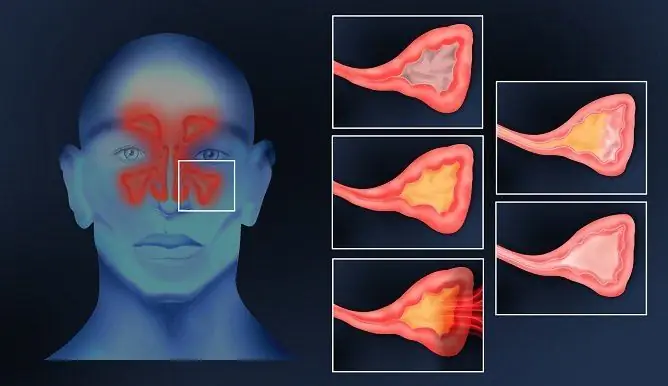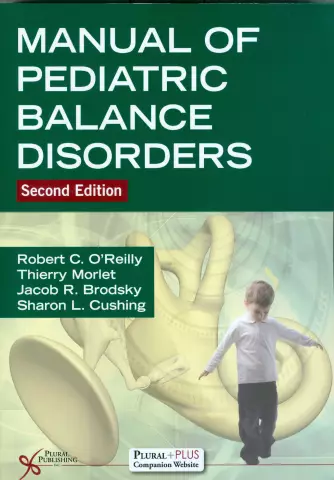- Author Rachel Wainwright [email protected].
- Public 2023-12-15 07:39.
- Last modified 2025-11-02 20:14.
A swab from the nose and throat for staphylococci, eosinophils: what is it?
The content of the article:
- Indications for research
- Eosinophil smear: what is it?
- Preparing for a throat and nose swab
- How is a nose and throat swab taken?
-
How many days does the analysis take?
- Antigenic tests
- Bacteriological examination
- PCR
- Decoding the results
A swab from the nose and throat for staphylococcus (microflora) is one of the types of bacteriological research, the purpose of which is to study the microbial flora of the nasopharynx. It allows not only to identify the microbe that caused the disease of the upper respiratory tract, but also to determine its sensitivity to antibiotics.
Indications for research
A swab from the nose and throat on the microflora is prescribed in order to identify the causative agent of tonsillitis (sore throat), pharyngitis. Some patients consider these diseases to be frivolous and therefore do not require any laboratory tests. However, you should be aware that they are often caused by group A beta-hemolytic streptococcus. The insidiousness of this bacterium is that it not only causes infections that affect the throat, but can also cause the patient to develop such serious illnesses as rheumatism and glomerulonephritis.

A swab from the throat and nose is taken to determine the causative agent of infectious diseases of the ENT organs
A swab from the nose and throat for staphylococci is most often prescribed to patients suffering from furunculosis. The fact is that very often the causative agent of this disease is strains of Staphylococcus aureus. They form colonies on the mucous membrane of the oral cavity, from where they get to the skin, causing purulent-inflammatory damage to the hair follicles.
Pharyngeal and nasal swabs are also performed if diphtheria is suspected. In addition, the indication for its conduct is the identification of carriers of Lefler's bacillus (bacillus) - the causative agent of diphtheria. In this case, in the direction to the laboratory it is indicated: "smear on Bl".
Eosinophil smear: what is it?
If the patient has symptoms of rhinitis for a sufficiently long time, then we can assume its allergic nature. To confirm the diagnosis, in this case, the collection of mucus from the nose for eosinophils is performed. Correctly this analysis is called a rhinocytogram. It is based on the analysis of the cytological picture, that is, the presence of certain cells in the studied biological material (erythrocytes, neutrophils, macrophages, eosinophils, lymphocytes, microorganisms).
With an allergic nature of rhinitis, the number of eosinophils will be increased in the rhinocytogram, and with a bacterial one - neutrophils. In order to carry out an additional differential diagnosis of these two diseases, the doctor may prescribe the patient and a blood test for leukoformula, which shows the ratio of white blood cell subpopulations to each other.
Preparing for a throat and nose swab
Preparation for analysis is quite simple:
- 72 hours before taking the biological material, it is necessary to stop the use of sprays, nasal ointments and throat rinses containing antibiotics or other antimicrobial agents. This is due to the fact that the drugs of these groups change the microbial ratio, which can cause an incorrect diagnosis and, accordingly, an incorrect treatment.
- In the morning, on the day of the test, you should not brush your teeth, drink and eat, as this can also cause changes in the microbiological and cytological picture of the smear.
How is a nose and throat swab taken?
To take a swab from the throat, the patient is asked to tilt his head back slightly and open his mouth wide. The tongue is pressed with a spatula and carried along the mucous membrane of the pharynx and tonsils with a sterile cotton swab wound on a thin stick. The procedure is completely painless, but unpleasant, since touching the tampon to the back of the throat can provoke quite strong vomiting.
When taking a nasal swab, a sterile swab is first introduced into one and then into the other nostril and passed along the walls of the nasal cavity.
The procedure for taking a smear in children is exactly the same as in adults. When taking material from a child in the first years of life, an assistant is needed who will fix the baby's head at the time of the procedure.
Swabs with pieces of mucus are transferred into a test tube with a nutrient medium or sterile saline solution, which, together with the direction, are delivered to the laboratory.
How many days does the analysis take?
The resulting material can be examined in different ways.
Antigenic tests
Rapid antigenic tests. They allow you to identify the presence of a certain type of bacteria in the mucus from the nasopharynx. This assay is most commonly used to detect group A beta-hemolytic streptococcus. Rapid antigen tests are highly sensitive and specific. Their result is ready within 10-40 minutes.
Bacteriological examination
Bacteriological culture. The mucus from the nasopharynx is transferred to a nutrient medium, and then the test tube is placed in a thermostat. In a favorable environment, bacteria begin to multiply actively, leading to the formation of colonies. This method of laboratory diagnostics allows you to identify the causative agent of a particular disease of the ENT organs, as well as determine its sensitivity to antibacterial drugs. The duration of bacteriological research is from 3 to 10 days.
PCR
Polymerase chain reaction (PCR). In the course of this analysis, it is established which microbes inhabit the cavity of the nose and throat by their DNA fragments contained in the mucus. Depending on the technique used, the duration of the study ranges from several hours to several days.
Decoding the results
Deciphering the analysis of a smear from the throat and nose is quite difficult. For a correct assessment of the results obtained, the relationship between the identified microorganisms and the existing pathology should be taken into account. For example, if a patient suffers from recurrent furunculosis, then the detection of Staphylococcus aureus in a smear will be of diagnostic value. At the same time, the detection of candida fungi in the same patient is not a basis for the diagnosis of mycotic lesion and, accordingly, does not require treatment.
Even in a perfectly healthy person, different microorganisms can be found in the sowing of mucus from the nose and throat. The presence of opportunistic microbes is a variant of the norm if their number is insignificant and they do not cause disease.

Bacteriological culture of material taken from the nose and throat allows the identification of the pathogen and determination of its sensitivity to antibiotics
Microscopic examination of a nasal swab may show the following cell types:
- eosinophils - normally they should not contain more than 10% of the total number of leukocytes in a smear. An increase in this indicator is a laboratory sign of allergic rhinitis. At the same time, the normal content of eosinophils does not completely eliminate the allergic nature of rhinitis. Another reason for the increased content of eosinophils in a nasal swab can be eosinophilic non-allergic rhinitis;
- neutrophils - an increased content of neutrophils in the smear indicates that the inflammatory process in the cavity is caused by bacteria or viruses and is in an acute stage;
- lymphocytes - an increased level of lymphocytes in the rhinocytogram is most often caused by chronic inflammation of the nasal mucosa;
- erythrocytes - normally absent. Their appearance in a smear is associated with increased permeability of the walls of blood vessels of the nasal mucosa, which is observed in rhinitis caused by the influenza virus or diphtheria bacillus.
YouTube video related to the article:

Elena Minkina Doctor anesthesiologist-resuscitator About the author
Education: graduated from the Tashkent State Medical Institute, specializing in general medicine in 1991. Repeatedly passed refresher courses.
Work experience: anesthesiologist-resuscitator of the city maternity complex, resuscitator of the hemodialysis department.
Found a mistake in the text? Select it and press Ctrl + Enter.






